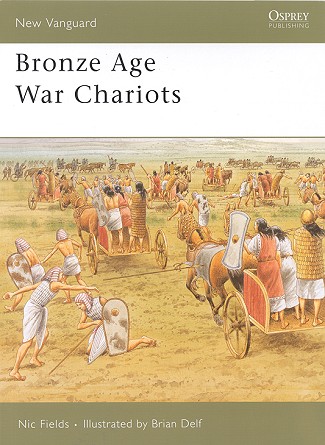 The
chariot is something most of us have heard about, and even seen if we have
watched Ben Hur. But how about the beginnings of the chariot? Is it
one of those things that have been around forever?
The
chariot is something most of us have heard about, and even seen if we have
watched Ben Hur. But how about the beginnings of the chariot? Is it
one of those things that have been around forever?|
Title: |
Bronze Age War Chariots |
|
Author: |
Nic Fields, illustrated by Brian Delf |
|
Publisher/Distributor |
Osprey |
|
Price |
$15.95 MSRP |
|
Reviewer: |
|
| Notes: |
48 pages, 7¼ x 9¼
inches, softbound ISBN: 1-84176-944-4 |
 The
chariot is something most of us have heard about, and even seen if we have
watched Ben Hur. But how about the beginnings of the chariot? Is it
one of those things that have been around forever?
The
chariot is something most of us have heard about, and even seen if we have
watched Ben Hur. But how about the beginnings of the chariot? Is it
one of those things that have been around forever?
Well, two things had to happen before we could have such a thing. One is that we needed to domesticate the horse and the other is that we needed a wheel. Both of these things took place relatively close to each other in time and place. The horse was domesticated either in what is now Ukraine or a bit farther east. These were not the type to be ridden as they were too small. They were used for food and eventually to pull wagons. It would take many generations to breed a horse where one could ride it. If one wanted to ride something, there were donkeys, which were ridden much farther back on the animal's body than a horse.
The wheel was probably invented in the Fertile Crescent of modern day Syria and Iraq. Or perhaps in the Indus Valley. Regardless, early wheels were solid and massive, certainly not something that would inspire speed.
Eventually, two main 'battle wagons' were developed; one with four wheels and one with two. These were initially used in the area of Ur and the Sumerians over 4,000 years ago. These underwent a dynamic development into much lighter two wheeled vehicles as were used by the Egyptians around 1500-1600 BC and are probably the best handling of the bunch, thanks to its aft axle design. Like other similar vehicles, they were pulled by two horses. We then go through the Hittite and Mycenaean chariots.
These were used in two ways. One was as a mobile platform for archers and for men using short spears to take out foot soldiers. Some of these chariots were two or three man crews with the actual warrior sometimes covered in bronze armor. The other was to deliver armed men to the battle front and then to pick up who was left for advancing or in case of retreat.
The author, Nic Fields uses a lot of primary research in various museums to put together a truly unusual and fascinating story of the development of these vehicles. Together with Brian Delf's artwork and photos of pottery and building carvings, we can trace the chariot from its start until the end of the Bronze Age.
It is a book on a most interesting subject and one I'm sure you will find fascinating to read.
December 2005
Available in bookstores and hobbystores, everywhere, through Osprey Direct (866 620 6941; info@ospreydirectUSA.com) or at http://www.ospreypublishing.com/.
If you would like your product reviewed fairly and quickly by a site that has over 300,000 visitors a month, please contact me or see other details in the Note to Contributors.